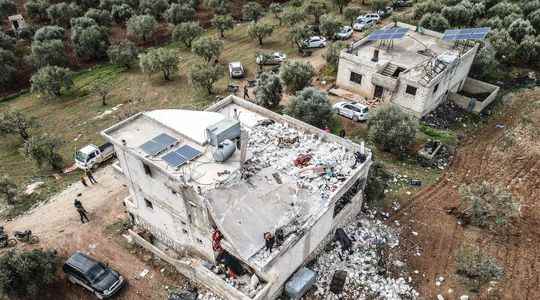In a short message, Joe Biden confirmed, Thursday morning, the death of the “caliph” of the Islamic State group: “Last night, under my direction, the American military forces successfully carried out an anti-terrorist operation. Thanks to the bravery of our armed forces, we eliminated Abu Ibrahim al-Hashimi al-Qurayshi from the battlefield.” The operation took place in northwestern Syria. It is the largest US raid in the country since the 2019 operation that killed Islamic State leader Abu Bakr al-Baghdadi. The American president assured that the American forces had “eliminated a major terrorist threat”. He took the opportunity to send a message to the leaders of terrorist groups around the world: “We are on your heels.”
The leader of the Islamic State group Abu Ibrahim al-Hachimi al-Qurachi, who died during a US operation in Syria, blew himself up “in a final gesture of cowardice”, said President Joe Biden, who claimed to have favored a commando operation to avoid civilian casualties. According to a White House official, the terrorist target detonated a bomb that killed him and his own family members, including women and children,” he said, noting that the assessment of the precise toll of the operation was still ongoing. “In a final desperate act of cowardice, and with no regard for the lives of his own family or others in the building, he chose to blow himself up, not just the belt (of explosives), but to blow up this third floor”, continued Joe Biden.
He added: “Rather than facing justice for the crimes he committed, taking several members of his family with him, as his predecessor had done.” At least 13 people were killed in clashes during and after the raid – including six children and four women – according to the Syrian civil defense group, the White Helmets. There were no American casualties, according to the Pentagon. Nicknamed “the professor” or the “destroyer”, Amir Mohammed Said Abdel Rahman al-Mawla, a jihadist with multiple aliases presented by the jihadist group as “the emir” Abu Ibrahim al-Hachimi al-Qourachi, notably presided over the massacre of the Kurdish-speaking minority of Yazidis.
Press Secretary John Kirby said in a statement late Wednesday that the mission was led by US Central Command, which controls military operations and activities in the Middle East. “More information will be provided as it becomes available,” the statement said. According to the OSDH, the soldiers landed by helicopter near camps for displaced people in the locality of Atmé and clashes then broke out. According to AFP correspondents on the spot, the operation targeted a two-storey building in an area surrounded by trees. Part of the building was destroyed and the floor of the rooms was covered in blood. Residents told AFP they heard the sound of helicopters, then “explosions”.
An operation carried out with the Syrian Democratic Forces
According to the OSDH, the American helicopters took off from a military base in the Syrian town of Kobani with a Kurdish majority, near the Turkish border. Members of the special forces of the Syrian Democratic Forces (SDF), dominated by the Kurds and trained by the United States, took part in the operation, according to the NGO. Ahead of the US announcement, Farhad Shami, the SDF spokesman, said on Twitter that the operation “targets the most dangerous international terrorists”. In an audio recording attributed to US forces and circulating among the population, a person speaking Arabic asks women and children to evacuate homes in the targeted area.
According to experts, overcrowded camps for displaced people in the Atme region, located in the north of the province of Idleb, serve as a base for the jihadist leaders who are hiding there. Much of Idlib province as well as parts of neighboring Hama, Aleppo and Latakia provinces are dominated by Hayat Tahrir al-Sham (HTS), the former Syrian branch of al-Qaeda. Rebel groups and other jihadist factions like Houras al-Din are also present there. These factions have already been the target mainly of air raids by the Syrian regime, its Russian ally, but also by the international anti-jihadist coalition led by the United States and American special forces. Nevertheless, helicopter operations remain very rare in Syria, where American troops are deployed as part of the anti-jihadist coalition.
Thursday’s operation came days after the end of an IS assault on an SDF-held prison in the northeastern Hassaké region. This assault was the most important offensive of the jihadist group since its territorial defeat in Syria in 2019 against the FDS aided by the international coalition. The attack on the prison and the fighting that followed left 373 dead, including 268 jihadists, 98 members of the Kurdish forces and seven civilians according to the OSDH. Al-Qaeda’s rival IS has been driven out of its strongholds in Syria and Iraq, but continues to carry out attacks in those two neighboring countries through sleeper cells. The complex war in Syria, a fragmented country where different protagonists intervene, has killed around 500,000 people since 2011.
